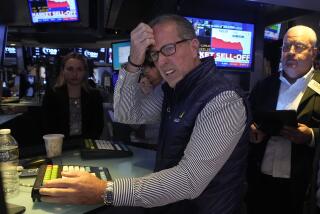Data sow fear; Dow plunges
NEW YORK — Falling gasoline prices aren’t enough to rescue the stock market from its funk.
That was clear Thursday as lackluster retail sales and a jump in unemployment claims pushed the Dow Jones industrial average down almost 350 points in its worst drubbing in more than two months.
The latest numbers were far from dramatic, but they reinforced a perception that any boost to consumer spending as a result of lower fuel costs is being offset by a fear among Americans that their jobs could be in danger.
Meanwhile, commodity prices again declined broadly Thursday. Rather than having a positive effect on stocks, the downdraft raised new concern that the picture could worsen if overseas economies, one of the few bright spots recently, continued to deteriorate.
The bottom line for the market, experts said, is that investors feel little incentive to buy stocks and won’t until clear signs of improvement emerge.
“We haven’t had any good news,” said Fred Dickson, chief market strategist at D.A. Davidson & Co. “There’s no surfacing of anything that can get investors excited.”
The Dow industrials skidded 344.65 points, or 3%, to 11,188.23. It was the blue-chip indicator’s worst showing since a 358-point loss on June 26. On the New York Stock Exchange, falling stocks trounced advancers by a ratio of 5 to 1.
The broader Standard & Poor’s 500 was off 38.15 points, or 3%, to 1,236.83. A technology-stock sell-off pounded the Nasdaq composite index, which slumped 74.69 points, or 3.2%, to 2,259.04.
The long-depressed financial sector, which had been gaining in the last week or so, was the day’s worst performer amid the return of anxiety about the effects of the credit crunch and the future of housing giants Fannie Mae and Freddie Mac.
Shares of Fannie Mae sank 12% on Thursday, while Freddie Mac declined 8%.
Bank of America tumbled 7.2%, Citigroup dropped 6.7%, JPMorgan Chase slid 4.5% and Wells Fargo fell 4.3%.
An index of financial stocks in the S&P; 500 lost 4.7%. It is down 39% in the last year.
Stocks of industrial companies, raw-material producers and tech companies also fell sharply on fears that battered European economies and cooling emerging markets will eat into demand for U.S. goods.
The sell-off demonstrated Wall Street’s change of attitude toward falling prices of crude oil, natural gas and farm products.
Crude futures, which closed above $145 a barrel in early July, fell $1.46 to $107.89 on Thursday. An index of 19 major commodities fell 0.6% and is now down 21% from its peak two months ago.
A few weeks ago, those price declines were welcomed as a desperately needed respite for cash-strapped consumers. The reversal in the commodity market helped stocks stabilize after their early-summer swoon.
But with commodity prices still tumbling, investors have begun to worry that one reason for the slide -- an abrupt slowing of economies in Europe and Asia -- will ricochet back to hurt the U.S.
Although lower commodity costs reduce inflationary pressures and yield greater spending power for U.S. consumers, a sluggish global economy could choke off American exports and lead to additional job losses in this country.
“This is ‘Be careful what you wish for,’ ” said Brian Bethune, an economist at Global Insight Inc. in Waltham, Mass. Lower commodity costs “will start to show up in much weaker import prices. However, it will also potentially clip the economy when it’s particularly weak.”
In the short term, lower commodity costs are worth the risk of weaker exports because food and energy prices fall quickly -- potentially boosting the consumer right away -- while economic softness overseas takes a while to filter back to the U.S., said Mark Zandi, chief economist at Moody’s Economy.com.
“The lower energy prices and food costs that should result will be more of a plus than the negatives resulting from lower exports, at least in the next six months,” Zandi said.
But a prolonged downturn overseas would certainly hurt the U.S. over time.
“You’re running the risk of turning off the exterior locomotive when there’s no other locomotive pushing the train,” Bethune said.
In the meantime, the woes overseas are depressing foreign stock markets.
Brazil’s main index sank Thursday to a 52-week low, down 30% since late May. Shanghai’s composite stock index hit a 52-week low Wednesday.
And the European Central Bank, though still expressing deep concern about inflation, tacitly acknowledged a recessionary threat Thursday when it held its benchmark interest rate steady to avoid hampering growth.
In the U.S., Thursday’s economic data underscored the precarious state of consumer spending.
Claims for new unemployment benefits jumped 15,000 last week. That raises the likelihood, experts said, that a closely watched government report coming out today will show that the economy lost jobs in August for the eighth consecutive month.
Most major retailers released disappointing results for back-to-school shopping, adding to evidence that the benefit of the government’s stimulus checks has dissipated.
“The reality is setting in that the U.S. economy is not going to be in a snap-back mode any time soon,” said Bruce Bittles, chief investment strategist for Robert W. Baird & Co. in Milwaukee.
--
More to Read
Inside the business of entertainment
The Wide Shot brings you news, analysis and insights on everything from streaming wars to production — and what it all means for the future.
You may occasionally receive promotional content from the Los Angeles Times.









